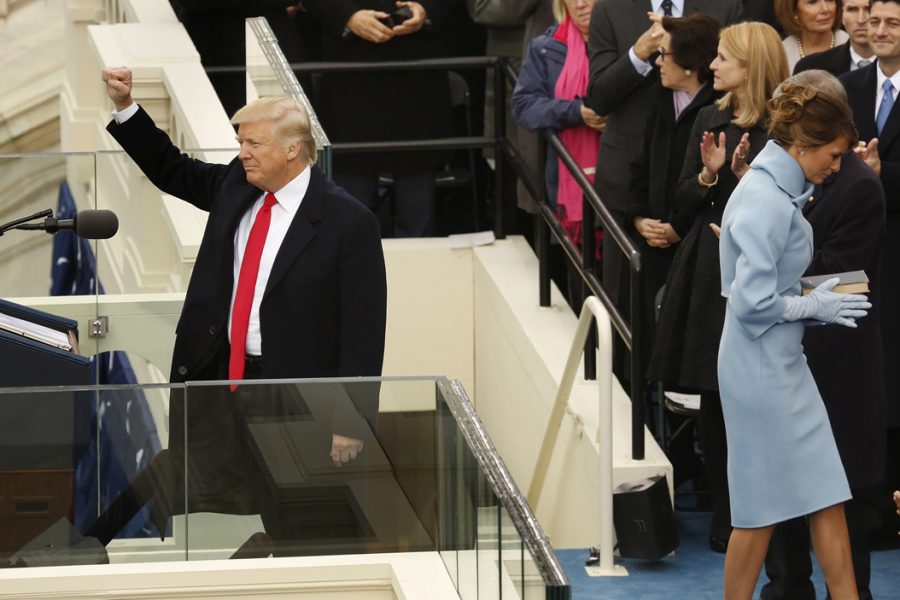Even before attending Donald Trump’s inauguration and the Women’s March on Washington, I knew this past weekend would be historic.
Trump thought the same, for different reasons than I, promising an “unbelievable, perhaps record-setting turnout” for his inaugural ceremony. Like so many of his promises, this was simply not meant to be.
It’s impossible to know the exact number of attendees at Trump’s inauguration, but aerial photographs show an underwhelming crowd, one that paled in comparison to the number of people who turned out for the next day’s Women’s March. This distinct difference, and the lies told about the crowd afterward, clearly demonstrate Trump’s lack of dedication to unifying America the way a president should.
The crowd at Trump’s inaugural address — which crowd counting experts, who used photographs and video to calculate data on crowd density in conjunction with city officials and D.C. Metro approximations, estimated to be 160,000 strong — left plenty of space at the back of the National Mall largely unoccupied. But the estimated 500,000 who gathered for Saturday’s Women’s March filled in that previously vacant area well before the march began. The D.C. Metro, which operates the District’s subway system, reported 275,000 riders by 11 a.m. on Saturday, compared to only 193,000 by that same time on Inauguration Day.
All available metrics clearly demonstrate that Trump’s “record-setting turnout” was anything but, while the Women’s March proved to be the largest protest in D.C. since Martin Luther King Jr.’s March on Washington in 1963.
The two events differed not just in crowd size, but in almost every perceivable way. At the inauguration, I was struck by the relative racial uniformity of the crowd. Footage revealed this lack of diversity in his voter base, a sea of faces in varying shades of beige, dotted sparsely with people of color. Feminist icon Gloria Steinem, on the other hand, noted in her speech at the Women’s March that the protesting crowd was “wide in age” and “deep in diversity.”
As a result of this diversity, the Women’s March touched on a multitude of progressive issues. Chants of “Black Lives Matter” and “Undocumented, Unafraid” echoed through the streets of the capital, and some protesters carried signs promoting respect and protection for Muslims.
Trump’s inaugural ceremony, conversely, had a distinct lack of ideological diversity. His inaugural speech could have been delivered on day one of his campaign. Virtually nothing in the speech deviated from his positions on the campaign trail, and he relied on many of his old talking points — particularly the negative effects of globalization on American industry and the sentiment that politicians don’t work for the average American.
Opposing ideologies were sidelined. When Senate Minority Leader Chuck Schumer, D-N.Y., delivered a speech that focused on the peaceful transition of power and Constitutional promises, he received a round of boos and jeers from the audience.
But the most striking difference was the overall attitude of each event. Trump’s inaugural address was particularly joyless, painting a bleak picture of America. He described “mothers and children trapped in poverty in our inner cities,” and stated his desire to end the “American carnage” of crime, gangs and drugs “that have stolen too many lives and robbed our country of so much unrealized potential.” While it is indisputable that all of these are problems, Trump exaggerated the severity of them — particularly violent crime, which has dropped 16 percent since Obama took office in 2009 — to highlight the need for his leadership.
The Women’s March, to the contrary, was remarkably joyful and upbeat, despite being a march based initially on frustration, fear and hurt. Spontaneous bursts of cheering erupted on numerous occasions and many in the crowd expressed hope for the future based on the massive turnout.
I talked with one woman who had driven all the way from Chicago to attend the protest. She said the march made her feel more optimistic about America’s future and about the possibility for real change.
Trump’s inauguration speech played on the fears of his supporters, making him the only possible changemaker, while speakers on Saturday highlighted the immense potential and strength of millions.
The protesters’ joyous attitude came from feelings of solidarity and love for their fellow Americans. Many marchers carried signs calling for women to come together in unity against Trump. Other signs quoted “Hamilton” creator Lin-Manuel Miranda’s acceptance speech at the 2016 Tony Awards: “Love is love is love is love is love is love is love is love is love.”
The massive success of the Women’s March, bolstered by the paltry turnout at Trump’s inaugural ceremony, is proof that Trump’s divisive approach to politics has only hindered him. He refers to his political opponents as “the enemies,” and his inaugural address was missing all but the most vague attempts to reach out to the other side of the aisle. Trump is clearly not interested in creating unity, and that will continue to fuel public disdain.
But he should be interested — whether he likes it or not, he is now the leader of all Americans, not just his voters.
I know he saw them, but I hope he also listened to the marchers assembled in front of the White House Saturday. Maybe they could teach him a thing or two about compassion and respect.
Nick primarily writes on politics and American culture for The Pitt News.
Write to Nick at [email protected].



